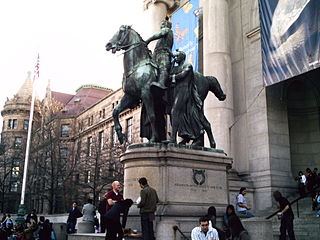
The Roosevelt Memorial Sculpture outside the American Museum of Natural History. Image Credit: Wikimedia Commons/MacLachlan
Jeffrey Kroessler’s view on the Teddy Roosevelt statue at the entrance to the Natural History Museum is clear and provocative, even if I have no certain answer to the questions it raises.
We are one-by-one re-evaluating our historical and cultural and artistic greats as we take a good look at things that used to be overlooked, especially their and our ignorance of, or support for, the injustices and cruelties of their times. I am in favor of this re-evaluation, but not in favor of focusing so closely on the flaws (a gentle term in some cases) that does not allow acknowledging the good some of these same people achieved. There are some extreme examples that are easy to decide—we are not interested in any ‘discoveries’ Josef Mengele might have claimed from his work, and I would personally donate a crowbar to any mob heading to take down any statue of him if there were one.
But, as we know, almost every hero of government, literature or art carried or carries flaws, was party to sins or crimes. Sometimes these sins were terrible ones, sometimes less horrible but still disappointing weaknesses or even sometimes cruelties. I personally love the conservationist legacy we owe to TR, and I don’t see that statue as embracing the horrible aspects of our history with Native Americans or Africans.
There are wide differences of degree in the various cases we’ve seen come up in recent years. For example, it bothers me that I can no longer relax and enjoy watching or reading Woody Allen, but that is different from contemplating people who, horribly, owned other people and bought and sold them as chattel or bred them as livestock. The contemporary view of Jefferson is discordant or even painful.
I read Jeffrey Kroessler’s piece as calling for a clear and specific examination of each case—and in the case of TR, he thinks a closer scrutiny does not support the statue’s removal.
As a public school student with radical and race-conscious parents, I never found this group statue offensive. I thought the two men (yes, I know, always men!) with him were his collaborators in whatever adventure they were heading to, maybe because the figures are obviously strong, proud and clear-eyed as they walk. So, the statue did not bother me as a NYC school kid even though I did object to the dioramas or displays just a few yards away inside the building that treated various other cultures as curiosities, lesser ‘species’ roughly like the stuffed animals in other dioramas. The statue definitely included the two cultures standing by TR, while those depictions inside I knew even as a kid were demeaning. And no matter how finely I focus my eyes and the critical parts of my brain, I can’t stop thinking about the Antiquities Act, the national forests and parks, and the many similar achievements TR, sometimes called “the Conservation President,” bequeathed to us.
I join Jeffrey Kroessler in thinking the statue should stay. But the Museum can go further. It should make a permanent installation on this difficult discussion and the Museum’s relationship to cultural dominance, and what this all means for our democratic culture.
By: Brendan Sexton (Brendan Sexton was previously President of the Municipal Art Society and a former Commissioner of the NYC Department of Sanitation.)


Thank you for publishing these thoughtful opinions on this well-known statue honoring Teddy Roosevelt. Explicating the messages conveyed by the posture of the three figures opened my eyes to the import of the monument that I so often passively observed when entering the Museum.